Environmental, Social and Economic Impacts of Fracking
Info: 8242 words (33 pages) Dissertation
Published: 20th Dec 2021
Chapter two: Literature Review
2.0 Introduction
The aim of this chapter is to illustrate the fracking operation in oil exploration and identify its impact on environmental, social and economic standards for countries and in turn clarify the main reason beyond choosing this particular option for oil and gas explorations. Following that, a case study has been chosen to give a brief information about all potential aspects of the fracking operation in South Africa, particularly in The Karoo. This chapter will also exam professional perspective in oil and gas industry to explore in more details their opinions about fracking operations and its impacts on the region.
2.1 Fracking
Oil and gas played a key role in the human kind life, therefore, through the years’ various types of strategies have been used in order to extract hydrocarbons for deep undergrounds. Till mid of the 1990 conventional ways were used to explore oil and gas (Sarrocco, C. 2015). However, with the great revolution in technologies and significant demand for oil and gas sources, many unconventional ways were suggested in order to extract unconditional hydrocarbons in deep ground and in various deformations. Fracking, ‘fracturing’, unconventional oil reservoirs or ‘tight oil and gas’ various liable were used to describe the techniques (Behen, L. 2014).
However, it can be described as simulation technique that is used in middle on 19th to increase the production of hydrocarbons from very poor or tight reverses the process involved tow technologies, hydraulic fracturing and horizontal drilling (Holloway, M.D., 1963, Rudd, O. & SHEDL. 2013).
Where the process initiates with drilling the ground vertically and then when the drilling reaches to the point where shale layers can be found a horizontal drilling will start in order to reach most of the porosities and gaps that contain oil or gas (Stephenson, M.H. & SHEDL Elsevier,2015). Horizontal drilling can extend more than 1 mile from the vertical borehole. After this stage, a fracking fluid will be pumped in order to frack the rocks that have trapped oil and gas (Samuels, A. 2013)
According to Environmental Production Agency (EPA), around 9000 pounds per square inch of pressure will be added to break the rocks (US EPA.2017). While various types of fluid were used in the operation among these is slick water, which is mostly water and can also contain any chemical additives detergents, alcohol, lubricants with different percentages that depend on the formation of the ground layers.
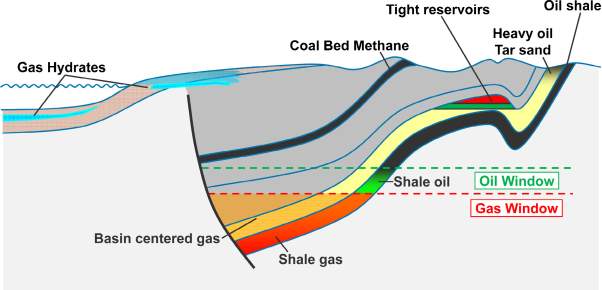
Figure 1: illustrates the type of formations and shale gas positions
Thus, in recent years, these operations have gained great influence due to its great benefits start with gaining revenues, financial benefits to the companies and significant amount oil and gas productions (nvestopedia.com.2017). For instance, the fracking operation is part of oil and gas production in the United States of America. Since 2005, around 137,743 oil wells are fracked by using 239,166 million gallons of water in addition to the different materials and additives such as methanol and hydrochloric acids that were used to provide hydraulic pressure on the formations to produce oil and gas (EPA annual report. 2017).
| State | Well fracked | Water consumed | Land distributed |
| Arkansas | 6496 | 11290 | 22858 |
| California | 3405 | 237 | 15940 |
| Pennsylvania | 9233 | 24732 | 52813 |
| Texas | 54956 | 120215 | 257,272 |
| New Mexico | 4318 | 3132 | 35273 |
| Total |
Table 1: illustrates fracking trends in the United States of America
* Water consumed in million gallons
* Land distributed in square kilometres
Shale gas development has put significant higher risks on social, environmental and health and safety prospects than conventional hydrocarbon developments due to many factors such as using many technologies to make it economically recoverable, a great benefit for investing companies and low requirement of equipment (Hawkins, J. 2015). The figure below illustrates the historical trend of US Department of Energy funding of natural gas and environmental and related research it is clear that during the recent 10 years the funding for environmental researchers has decreased and funding for natural gas researches and technologies has reached its lowest point during the same period. All these parameters had great impacts on the conventional hydrocarbon resource extractions and global trends towards unconventional resources (EIA,2011).
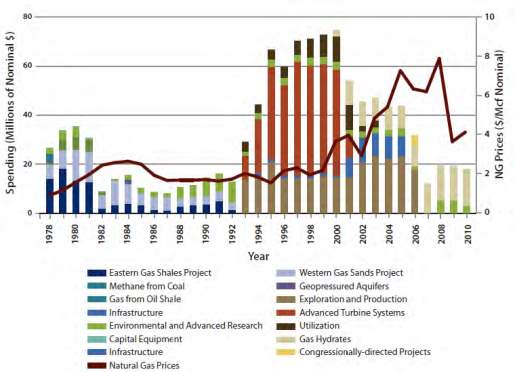
Figure 2: shows US Department of energy and natural gas funding history, 2012
2.2 Fracking Technologies
If shale gas extraction technologies can be developed feasible in an environmentally friendly way there will be a considerable economic benefit of it. Since discovering shale gas in the 1900s (Massey, K. 2016). There was a great interest in investing in this field and according to that many technologies has been used to explore unconventional hydrocarbons. Unconventional ways including fracking were always a source of debate about its potential concerns (Howarth, R.W., Ingraffea, A. & Engelder, T. 2011).
First enhancing of hydraulic fracturing in petroleum field were early in the 1900s which used to extract natural gas from shale wells, vertical wells which fractured with foams. The development of this method of extraction was continued till 2007 where start to use of new technologies enclaved multi-well pads and cluster drilling (Bažant, Z.P., Salviato, M., Chau, V.T., Visnawathan, H. & Zubelewicz, A. 2014)
Table 2: hydraulic fracking technologies milestones (1900-2007)
| Hydraulic Fracturing Technologies Milestones | |
| Early 1900s | Natural Gas Extracted from Shale Gas Fractured with Forms |
| 1983 | First Gas Well Drilled in Barnett Shale in Texas |
| 1980-1990s | Linked Gel Fracturing Liquids Developed and Used in Vertical Wells |
| 1991 | First Horizontal Well Drilled |
| 1996 | Slick Water Fracturing Fluids Introduced |
| 1996 | Microcosmic Post- Fracturing Mapping Developed |
| 1998 | Developing in Slick Water Fracturing Fluid to Have more Chemical Additives |
| 2002 | Multi-Stage Slick Water Fracturing of Horizontal Wells |
| 2003 | First Hydraulic Fracturing of Marcellus Shales |
| 2007 | Using Of Multi-Well Pads and Cluster Drilling |
From the table above it can be observed that the hydraulic fracturing has been used since the 1900s and applied in conventional vertical wells (Fracking impacts”, 2015). Moreover, it can be seen that until 1991 the first horizontal drilling was observed, then it improved in 1969 to use slick water and some hazard chemical additives have been introduced.
According to the Energy Information Administration, the recent development of shale oil and gas has exposed the environment and health and safety of humankind to the direct risks and challenges of water pollution, air pollution, contaminated land and earthquakes (EPA report. 2017).
Furthermore, the hazard of these technologies like directional drilling, which involves high fracturing fluid volumes and the multi- well and cluster drilling that evolved using of hazard chemical materials that harm the environment such as, methanol and hydraulic acids.
3. Companies perspective from Fracking
With all the attention that’s paid to the potential aspects of fracking. Nowadays, it can be seen there is great engagement from companies to invest in upstream operations through unconventional ways especially fracking (Inman, M. 2014).
Yet, the location of the world from shale gas recovery operations are going tremendously high to ward fracking operation as an option of shale gas operations. However, according to the figure 3 below, which is illustrates the largest 20 countries with technical recoverable shale gas resources, the shale gas resources are separated worldwide and the most part that are the shale gas are located is in the area that are suffer from fresh water availably (Palliser, J. 2012). For instance, according to the ranking table in the appendix; China, Mexico and south Africa which are rich in shale gas basins and under high risks of water scarcity (Grose, T.K. 2011).
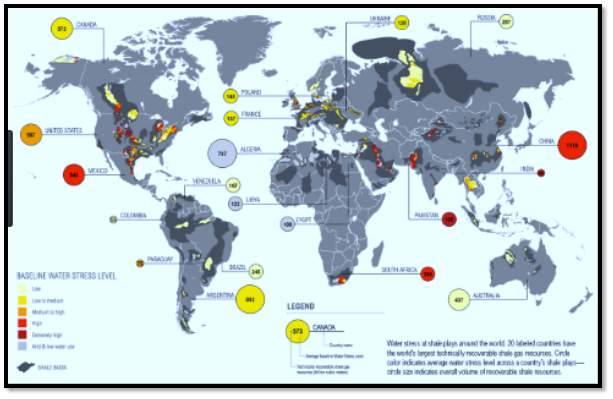
Thus all these facts and risks did not stop companies from investing in exploring shale gas through fracking. Where in 2016 around $20 billion were invested by oil compaines in fracking operations and unfortunetely many big companies wher involed in this operations dirctly or indirctly such as BP, Royal Dutch Shell, Exxon and Chervon. While fracking countedaround 51% of American oil productions last year (Iea.org. (2017).
OPEC anoused that nowadays the 20% of globale oil production oerations are depends on unconvetional hydrocarbons sources and around 30% of unconventional menthodes are depending on fracking (Oyedele, A.2017)
However, due to the great changes toward fracking as a potantial option. Companies claim that there is many resons of chosing this option. One of the most important options is the economic and current low price of oil market furthermore, the regulations and the frameworks that palyed tge key role in enhancing fracking options in oil industry (Russell, A. 2014)
3.1 Economical and current market situations
One of the noticeable reasons that make fracking a feasible solution in many countries is the current market situations, the low price of the oil in the markets has forced lots of big companies to search for more low cost options to extract oil and gain the best benefit out of it. As the global oil price fell from more than $100 a barrel in 2014 to more than $30 in 2016 (Ogfj,2017). These huge declines in oil price have made the oil countries and the industry itself suffer from feasibility of many options to extract oil. As the oil price feel the cost of conventional drilling and completion serves get high to more than 30% which put great emphasis on companies to make any profit. Therefore, due to the great properties of fracking operation such as low cost of drilling and equipment’s to reach half of the cost of the conventional oil resources make it more attractive for companies to invest in with making the environment pay the great cost (Ochieng, E.G., Price, A.D.F., Egbu, C.O., Ruan, X. & Zuofa, T. 2015).
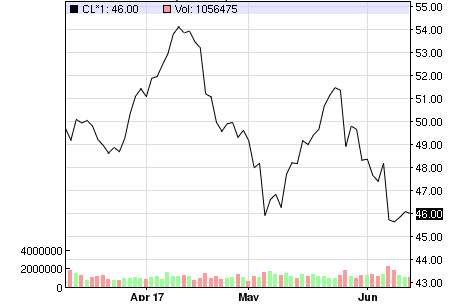
Figure 3 : illustrates current oil price
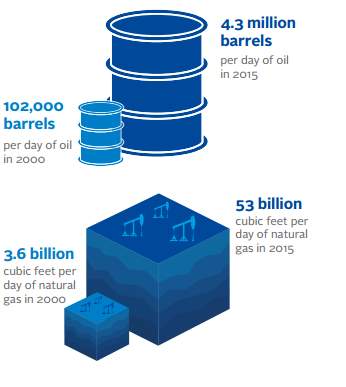
Figure 4: illustraites the trend of production of oil and gas by fracking wells in the world

From the figure above it is clear that the environmental impacts overly the benefits of the economic purposes.
3.2 Current regulations and frameworks
The current regulation of conventional oil and gas does not lead to adequate controls for the shale gas industry and fracking leads to a mismatches between regulation and uncertainty as to whether and how the rules apply regulation. It depends on controls in a wide range of sectors and media: waste laws, water quality, air quality, environmental impact and liability, chemical controls, noise emissions, planning and developed controls (Wernau, J. 2013). The Environmental Impact Assessment (EIA) Directive was created to control any threats on environment, but after having examined the current regulations of shale gas and fracking it is clear that the old regulations are being used to govern a new technology and there was not any clear framework for controlling fracking operation globally (Kubik, P.J. 2013). Although, a Strategic Environmental Assessment (SEA) in 2014 applied for the onshore licensing round to compels a holistic approach to risks and recording some series negative aspects and cumulative effects on social and general health, air quality, soil contaminated and water waste and scarcity on the local community, these all evidence are assumed to be mitigated on an acceptable level of risks and there is no real and direct threat on environment (Freilich, R.H. & Popowitz, N.M. 2012).
Nowadays, the uncertainty in relation of fracking operations and its drawbacks on the environment put it in a strong position for companies to invest in and improve the quality of fracking methods during hydrocarbon extractions.
Yet, all the new legislations and regulations that set to protect the environment and reduce greenhouse emissions that are held recently did not have any framework that may cove and limit fracking operation. the list below represent all the new legislation that set by UK and EU to control the climate change and air emissions furthermore, find a sustainable option for green energy with exemption any environmental damage by fracking operation (Response to Interior Department Fracking Regulations2015).
| Act | purpose | Fracking Exemptions |
| Clean Air Act of 1963 | Control air pollution at the national level | Treat each individual well as a source of pollution and does not require operation to consider the impacts of emission on environment on any area |
| National Environmental Policy Act of 1969 | Required federal agencies to contribute environmental assessment of federal action | Energy Policy Act in 2005 excludes oil and gas drilling form NEPA |
| Clean Water Act of 1972 | Ensure that the water meet the minimum pollution standards | Fracking fluid are exempted from considering it polluted although the large quantity of water that are used in the operation |
| Safe Water Drinking Act 1974 | Protect the quality of the country’s groundwater and the supplement source of the water | Aimed in 2005 to exclude the injection wells |
| Resource Conversation and Recovery Act 1976 | To regulate the produced waste for the protection of both environment and human | Waste from oil fields are excluded |
| The Energy Policy Act 2005 | Regulates the potential aspects of federal energy policy | Only regulate fracking when diesel flued are used in fracking fluid with any control of chemical and hazard materials that are used |
| Climate Change Act 2008 | Reduce greenhouse emission 80% by 2050 compared with 1991 | The emission from oil industry field where did not counted |
Figure 5: Fracking exceptions from federal policies
4. Potential risks from fracking operations
There is a large debate about fracking operation globally. While the economic impact of the fracking operation that opened a significant gate for it to be used widely. Ultimately it become hard to balance between the health and safety and environmental consideration from this operation and the economic benefit from it (Fracking risks”, 2012). Many studies have explored all the potential aspects of fracking on the environment and human health and it appeared that the environmental and health impacts are very important to consider. Thus, the main reason to consider all the potential aspects is (McLeod, D. 2013)
- Using around 750 known chemicals that are toxic for human being
- The large quantity of wasted water that are used for cracking the rocks and specially in the regions how are suffer from water scarcity
- Furthermore, the emissions that are produced to the air, noise
- Contaminated the lands how can be used for vegetation’s and farming
All these parameters should take in the consideration before choosing this method as potential options for oil and gas extraction.
4.1 Impacts of Fracking on the Health
Many studies have examined the existing impact of fracking on habitant and the wildlife. The major area of concerns is the materials that are used during the operations and it is with direct contact with humans and the surrounding communities (Paraventi, M. 2016). Furthermore, it is believed by Ruth Mc and his team works who are worked in the health and safety of oil industry fields; that the consequence of the fracking start from the early stage of drilling because of the potential risks of gas leaking at any stage of the drilling (Torjesen, I. 2013). Yet, this may put the individuals living a proximately close to the fracking sits are exposed to these hazard emissions. A study has been done in the California particularly in the Los Angeles region which consider to produce around the quarter quaintly of oil in the US; on the local community and individuals how are leaving close to the oil fields are complained about having nausea, nosebleeds, and respiratory illness and headaches and they refer all that sings to the high level of emissions in the air such as: methane, ethane, carbon dioxide (Willems, M., Dalvie, M.A., London, L. & Rother, H. 2016). Fracking caused a variety of health effects on the living creatures from the surrounding area where there were signs of many animals who are found died because of getting exposed to the waste materials that are produced from fracking operations (Meng, Q. 2015).
All these cumulative aspects of fracking have left the surrounding community suffer from different disease and force the individuals to leave the area how are close to the oil fields to areas are more salted and safe.
Furthermore, resulting of contaminated the used land with waste of oil and fracking fluids, mixing the ground water with the fluids that are used to expose the extra pressure on the formation in order to be cracked. Living in this area by human being was very stressful and dangerous (Tuller, D. 2015).
Although, many legislations and environmental agencies have been set to protect the environment and the shrouding communities from fracking operations but there was no significant movement towered these operations.
4.1.1 regulation context
It is always difficult to predicts about any accidents to take any clear action toward it. However, it is noticeable there is slow modification and reactions toward fracking, and the hazard chemical materials that are used in the operation and the serious danger that the sounding communities and the institutions employee are exposed to (Fink, J.K. & Knovel E-Books 2013).
In 2009, additional regulation has been proposed for fracking called ‘FRAC Act’ i.e. ‘Fracturing Responsibility and Awareness of Chemicals Act’ this act was designed to repeal the exception of fracking form Safe Drinking Water Act and; but unfortunately this act couldn’t justify the dander that the aquifer water is exposing to form fracking and the regulation action still dim due to the duty of the FRAC Act that responsible to trace the toxic materials in the aquafer water that are close to the fracking area (Fracturing Responsibility and Awareness of Chemicals Act of 2011)
However, the fear about the fracking operation is ongoing by the local communities and the environmental and human health and safety protectors and the trust to the oil companies are impossible especially after deep water horizon disaster (Hammond, G.P. & O’Grady, Á. 2017)
It seems likely the regulations about fracking will continue to be left in place that the when the local communities are cable to access to the all information about the chemical material that are used in the fracking operation and have a clear vision about the drawbacks of the operation so better regulation can be prepared.
Yet, nowadays there is great imposing for additional regulations about health and safety regulations for fracking but it requires more disclosure of information about fracking operations and with a long regulatory road of processing the site and producing reports to identify the risks and take a proper action (Gillen, J.L. & Kiviat, E. 2012)
4.2 The Environmental Impacts from Fracking Operations
The unconventional oil and natural gas extraction enabled by the horizontal drilling and hydraulic fracking (fracturing) is driving an economic boom while the consequence of the operation holds by the environment. The environmental concerns about fracking is relay between myth and the reality (Quinn, D. 2016) Where their s some major concerns about fracking threated the water and caused earthquakes other opponents are arguing that the benefit that can gain from fracking can cover all the damages (Fry, M., Briggle, A. & Kincaid, J. 2015). Furthermore, the poetical damages of fracking considered to be minor and yet there is no clear evidence about all these concerns.
However, this section will exam all the aspects that are occurs within fracking operation and then identify the impact of these aspects on the environment.
The most significant potential risks that environmental agencies are argue about can be summarized in the below points (Holloway, M.D., 1963, Rudd, O. & SHEDL Wiley Ebook Collection. Owned,2013)
- Water pollutions
- Ground water contaminations
- Waste disposal due to large usage of water
- Air pollutions
- Producing methane due to the operations
- Chemical gases produced to the air and gas leakage
- Contaminated land
- Disposal waste after or through operations
- Leakage of oil to the soil and destroy the land use
- Earthquakes due to adding extra pressure to the formations to fracture it
All these aspects are should be taken in to the consideration before starting any hard operation on the environment.
The figure below illustrates total environmental study paradigm of fracking.
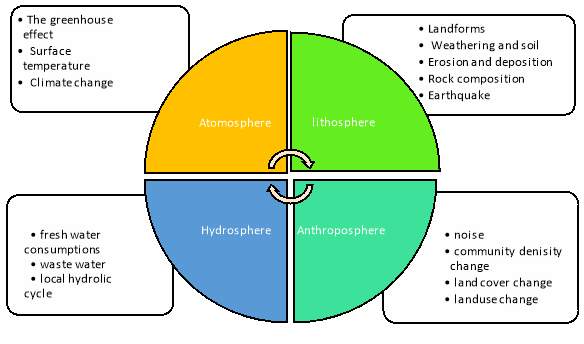
4.2.1 Fracking Impacts on Water
Fracking has become one of the hot topics in the public and there were always noticeable doubts about its environmental impacts and economic benefits. One of the considerations that the public and the researchers are arguing about is the water pollutions considering three major effects such as. Water consumptions, ground water pollutions and producing large quantity of waste water (Esposito, M. 2013,) Yet if hydraulic fracking can be described in an environmentally way it is can be explained as a geo chemical engineering process that involves a huge volume of water associated with certain amount of chemicals that are prepared specially for the well injections in order to fracture the tide rocks that holds the taped oil and gas (Proxy Season Report: FrackinG,2011) In USA, for example it is even called the high-volume horizontal hydraulic fracturing process (HVHFP). The major challenges that taken in the confederations of the researchers are about the ground water degradations (Burton, G.A., Basu, N., Ellis, B.R., Kapo, K.E., Entrekin, S. & Nadelhoffer, K. 2014,). For instance, fracking in the Marcellus Shale region in the North-eastern United State of America has raced a serious concern about ground water pollution and well water pollutions as well by doing tests of Methane level in the ground water which found migrated from fracking wells (Davis, C. & Hoffer, K. 2012). Furthermore, there are three main reason of contamination the ground water during the fracking process
- Poetical probability of the well blowouts
- Leakage of methane gas during the operation to the ground water
- Improper disposal of the fracking fluids
On the other hand, the consumption of water is another issue that thread the habitant; for instance, in order to using fracking method to extract shale gas or oil it will typically require around 2-20 million gallons of Water to with chemical additive that will not allow to recycle the used water again (Brantley, S.L. 2015). Thus, state of Pennsylvania has developed its fracking operation to be used in around 7000 wells therefore it is estimated that around 1.3 gal/MMBtu of water is used during the operation which is consider very high risks due to the high density of the area and that ultimately led to great damage to the habitant and the wildlife (Throupe, R., Simons, R.A. & Mao, X. 2013)
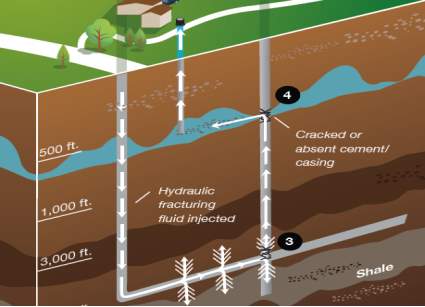
Many cases have been reported of actual contaminations of drinking water by methane in around 51 sample of drinking water in the USA other cases have been also noticed with the similar circumstance in Canada and Chania (Jackson, R.B., Vengosh, A., Carey, J.W., Davies, R.J., Darrah, T.H., O’Sullivan, F. & Pétron, G. 2014
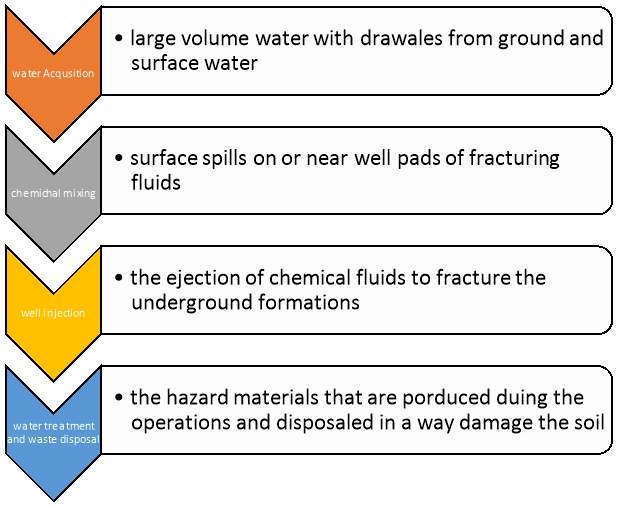
Although, all the potential concerns about fracking it is poorly regulated at the federal level for example its waste and waste water are hazardous material are not considered by t5he resource conversations and recover act. In addition, safe water act has no rules on fracking wells and fluids (Carter, A.V. & Eaton, E.M. 2016)
4.2.3 fracking impacts on air
By knowing all the concerns about the fracking on the water it is clear that the impacts go beyond that to affects the air quality of the area. it is observed by Karion et al., 2013 are mainly through greenhouse emissions especially methane which more efficient at trapping radiation than CO2. However, the researchers also found that the process of fracking that involves releasing of natural gas from underground emit pollutant s called PAHs (polycyclic aromatic hydrocarbons) including some emissions with high risks of cancer.
Kim Anderson who is the environmental and chemist in OSU’s sciences. Where collected air samples for sites are near to the fracking operations and oil refineries in Chicago and near to Belgian. the results were dedicated low level of greenhouse and toxic gas emissions while the results from the top of operations sites show 10 times of carbon dioxide and methane. This study has been done in this particular area due to the several complements for the citizens about many breathing difficulties and lung problems.
Another study done in Canada to analyse the emissions from shale gas operations and its potential impact on the climate change. According to the CCA council of Canadian Academics; it is around 2.7% of the air have methane and about 10% of the air contain greenhouse emissions (Senate committee examines EPA rule on air pollution from fracking, 2012).
These results classified as an acceptable and may not require any persuaders to process it. However, all these concerns under exam and further detail required to precise the concerns of fracking
yet, with the clear evidence of environmental impact of fracking there is a noticeable lack in the regulations and funds for such researches. thus, the oil and gas industry enjoy of the many exemptions that it had it from the federal legislations agencies. Such as, the clean air act that set to reduce greenhouse emissions did not cover that emissions that produced from shale gas (Vergano, D. 2012).
In 2015, the EPA has issued a general permit for air emissions but it only involves the emissions from the production stage it does not include cleaning the land or the complete phase which includes fracking stage (Vergano, D. 2012)
4.2.4 Fracking and the land contaminations
Oil industry operation’s always put extra risks on the landowners due to the hard operations and heavy materials that are used during the operations. Furthermore, the waste materials that are produced and it contain hazard materials on the environmental and lands (‘Promised Land’ goes easy on fracking issues 2012). However, fracking holds the major positions from these impacts on the land use due to the heavy chemical materials that are used during the drilling. Since hydraulic fracturing occurs on agriculture land which put great pressure on this are. Were it is noticed after a 6 months to 1 years the top soil of the area is heavily damaged furthermore, it fully covered with hazard chemical materials that is need around 10 to 14 year to be cleaned and repair it for using (Dokshin, F.A. 2016)
A study has been done on the sounding and used area for fracking in Huston city in USA in 2003 to test the quality of the soil, the indicate the greater impact than what it reported on the urban area with preventing the area to be used for agriculture proposes (Rawlins, R. 2014)
Another study done in California which one of top nations agriculture producer, the study concluded that the fracking operation had affected the activates of agriculture land due to the soil and land contaminations which in turn affect the life on the livestock.
While the most common findings across all the studies that have been done to identify fracking impacts on the environment were in common with exposing the water, land use to a significant threat of contaminations (McLaughlin, M.C., Borch, T. & Blotevogel, J. 2016)
In fact, all the environmental impacts of fracking can be described as a circle which connect with each other in a certain way. Where in any area noticed with water contamination that affect the habitant human life the vegetation’s and soil degradations. By finding one aspects in the area that means that normal standard living will be impossible.
4.3 Geological Risks
One of the geological risks that the fracking operations are involve in is earthquakes. Multi earthquakes occur at many regions around the world where there is a complex fault exist. Usually do not stand the high stress form at different locations subsequently great damage to the structures and earthquakes (Davis, C. & Fisk, J.M. 2017). The developing of the conventional oil and gas resources using horizontal drilling and hydraulic fracking by injecting water in to the formations has not environmentally preferred due to an increasing concern about injecting fluids in to the unstable formations may raise the rate of the seismic activity. It is estimated the number of earthquakes of magnitude of 3 or greater in the central and eastern of the united states of America where the fracking operations and injections wells activates has found and increased (Booher, J. 2015).
The potential damage that the hydraulic fracking may cause it is under investment. The techniques itself includes fracturing intentionally create fracture in the tight rock that holds the tight oil and increase the flow of the oil. Furthermore, this technique depends directly on inducing micro seismicity mostly range from 0.5 to 1.0 magnitude (Fracking, Earthquakes Raise Infrastructure Worries”, 2014) Although it’s too small to feel but it may cause damage to the subsurface. It is estimated that the hydraulic fracking was responsible of earthquakes larger than magnitude 2.0. the assessment has done in sites of different countries with various formations such as, Oklahoma, Ohio and England. While in the western of Canada the earthquakes were associated with earthquakes found to be greater than magnitude 3.0. in 2011, in Blackpool in England, hydraulic fracking and injection activates has led to series of small earthquakes ranging up to 2.3 magnitude (Fracking Linked to Earthquakes in Ohio”, 2013).
These seismic where not strong enough to cause any damage at the surface. But it was strong enough to deform the well casing equipment’s that were used for fracking the shale gas bearing formations (Clary, R. 2015)

The Environmental Protections Agency’s Underground Injection control (UIC) program under the SAFE Drinking WATER ACT (SDWA) regulate the subsurface injection wells by issuing six class of injection wells including the class ii used for oil and gas water disposal and enhanced recovery (Anticipating hazards from fracking-induced earthquakes in Canada and US”, 2017). the EPA framework consist of certain well classes need different evaluation of seismic risks. Although, the EPA did not regulate the other five classes of the well. But it put significant frameworks for the class II which is considered to be a good move toward understanding the environmental and geological damages that the fracking operation are involve in (Fracking confirmed as cause of rare ‘felt’ earthquake in Ohio”, 2015).
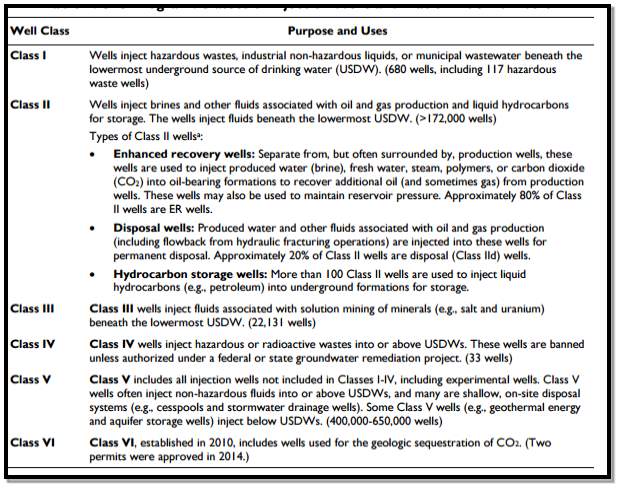
By identifying all the negative and positive aspects of fracking operation, the next section will focus more about fracking aspects in the South Africa specially in Karoo to identify in more details all the potential aspects that fracking may cause it in the area.
4.5 Karoo basin
4.5.1 Background
Karoo is south Africa’s semi-arid region it occupied around 700,000 Km2 from the total area of South Africa. It considered to holds critical position in the country’s economy due to its great contain of hydrocarbons. The climate of the region can be described as dry and with low rate of rain associated with high temperature. Karoo region have low population around 71,011 people in 2011. The region topography considers to be sand stone and shale which provide great opportunity to accumulate oil and gas between traps. Thus, due to the hard climate that Karoo region have it suffered from many environmental issues of water sacristy, low vegetation areas and health concerns due to the high rate of poverty.
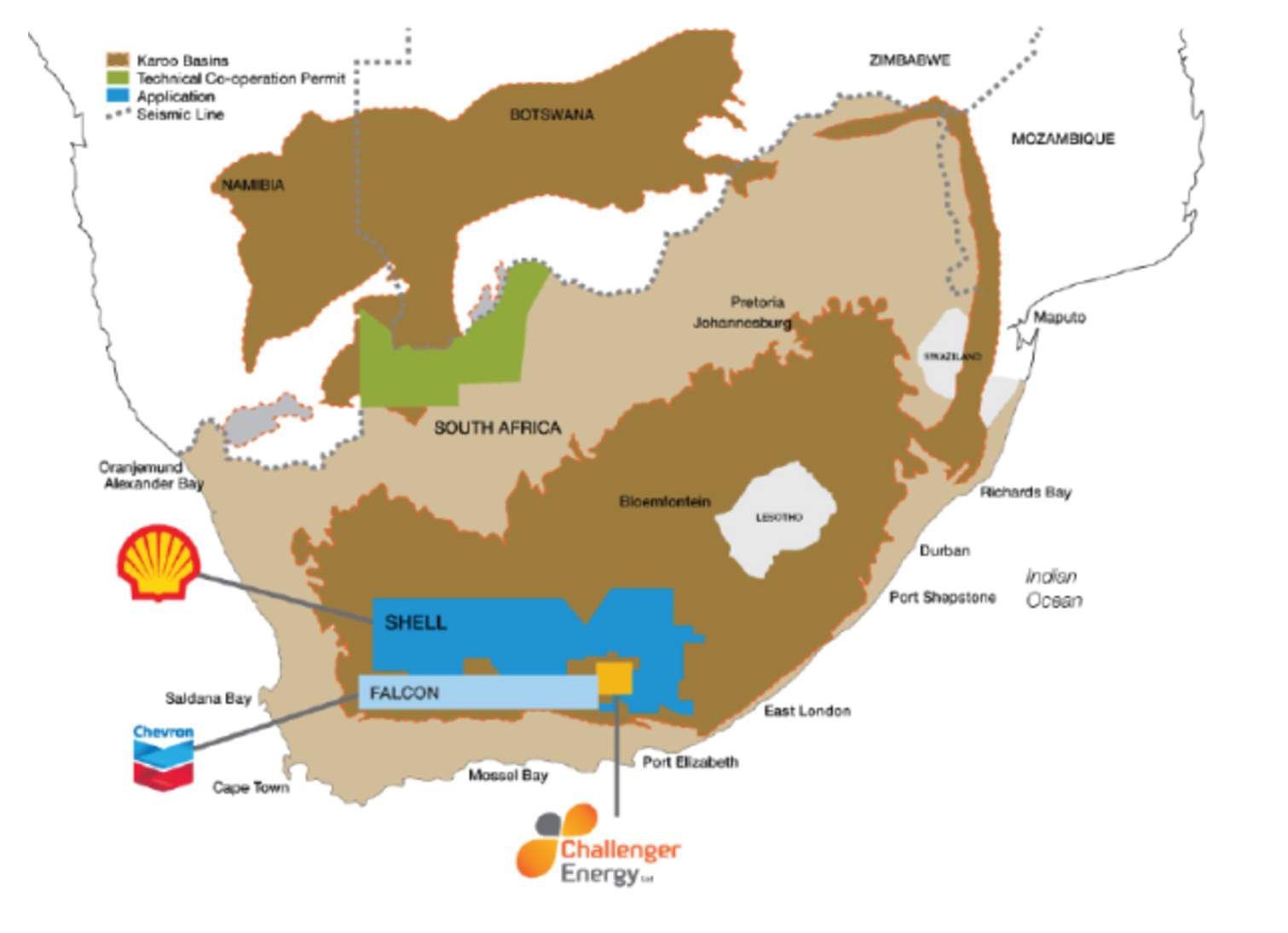
Figure 8: illustrates Karoo region
4.6 Hydrocarbon sources and fracking
Karoo region one of the richest area in hydrocarbon sources. The initial petroleum exploration in the Karoo region starts between 1960s and 1970s by using conventional ways to extract oil and gas. However, by the raped development of oil and exploration methods; the new target of using unconventional ways to extract hydrocarbon represents in shale gas, coalbed methane and biogenic gas. Yet although, the noticeable increase in unconventional hydrocarbon extraction, it had great environmental concerns on biodiversity, soil contamination, air pollution and groundwater hazards.
4.6.1 introduction
South Africa has major sedimentary basin that contain thick and organic rich shales. However, the Karoo basin occupied area of 236,400 mi2 which is extending across tow third of the country with the northern portion of the basin are favourable for the shale gas. The climate of the groin can be very harsh with high temperature and low rain participations. Therefor the vegetation area can be describing as low as it is vast open area which suffer from water scarcity. The region depends mainly on the framing and tourism as a source of living.
Karoo basin is an area facing an implementation of hydraulic fracking currently as many countries applied to invest in its shale gas and fracking such as France, United State of America and Poland. These type of activates will put extra emphasis on the region as it already suffers from climate change and high temperature furthermore has low water sources and suffer from water scarcity.
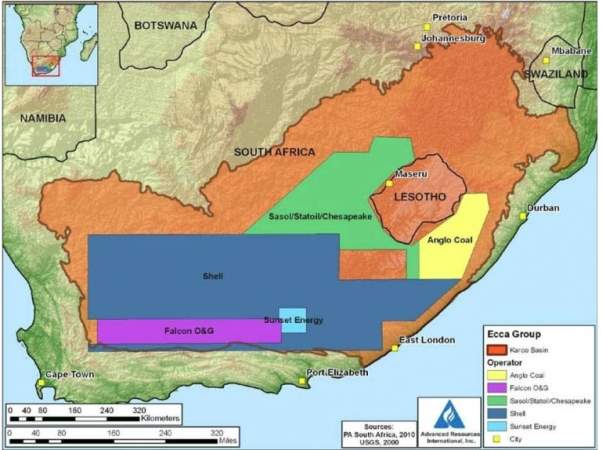
Figure 7: Illustrates exploration are in the Karoo region
4.6.2 The environmental consequences of fracking
Fracking operation has great consequences on the ground water, air, soil and biodiversity of the area. Thus hydraulic fracturing required an immense amount of water during well simulation as the quantities of water that are used in fracking operation may reach to millions of litters per well which is around 2300,000 gallons of water per year
This is an important aspect that should the country take in consideration before conducting fracking operation. As according to the current situation of the countries low level of rain falls and hot climate make its very challenging to waste all that water on fracking operation to extract oil and gas

Figure 6: rainfall levels in South Africa
The sources for providing the fresh water for fracking will be challenging in area like Karoo which is already dry region and the access for the fresh water should be available for the people who are living there. In addition, hydraulic fracking has great impact on the ground water as threat is great potentials of escaping shale gas to the ground water and contaminate it as it will be very difficult to clean. Therefore, the country will be under great threat of water scarcity if this type of accident happened.
References
EPA annual report. (2017). [online] USA. Available at: https://www.epa.gov/sites/production/files/2016-04/documents/epa_research_yearbook_final.pdf [Accessed 26 Jun. 2017]
EPA report. (2017). [online] Available at: https://www.epa.gov/sites/production/files/2013-12/documents/ord-annual-report-2012_0.pdf [Accessed 26 Jun. 2017].
Fracturing Responsibility and Awareness of Chemicals Act of 2011. (2017). [online] USA. Available at: http://mpaenvironment.ei.columbia.edu/files/2014/06/FRAC-Act.pdf [Accessed 26 Jun. 2017].
Iea.org. (2017). OMR – OMR Public. [online] Available at: https://www.iea.org/oilmarketreport/omrpublic/ [Accessed 26 Jun. 2017].
Ogfj.com. (2017). Oil Markets. [online] Available at: http://www.ogfj.com/oil-markets.html [Accessed 26 Jun. 2017].
“Fracking impacts”, 2015, Nature, vol. 522, no. 7555, pp. 132.
Proxy Season Report: Fracking 2011, Water Scarcity, Other Issues Show Shareholders Resolute on Climate & Related Sustainability Resolutions”, 2011, China Business Newsweekly, , pp. 36.
Anticipating hazards from fracking-induced earthquakes in Canada and US”, 2017, NewsRx Health, , pp. 134.
Bažant, Z.P., Salviato, M., Chau, V.T., Visnawathan, H. & Zubelewicz, A. 2014, “Why Fracking Works”, Journal of Applied Mechanics, vol. 81, no. 10, pp. 101010.
Behen, L. 2014, “Fracking”, The Catholic Library World, vol. 84, no. 3, pp. 222.
Booher, J. 2015, “FRACKING—CAUSED EARTHQUAKES: HOW ALLEGED THREATS COULD TRIGGER THE CORPS OF ENGINEERS’ SECTION 10 JURISDICTION”, Environmental Law, vol. 45, no. 1, pp. 235-255.
Brantley, S.L. 2015, “Drinking water while fracking: now and in the future”, Ground water, vol. 53, no. 1, pp. 21.
Burton, G.A., Basu, N., Ellis, B.R., Kapo, K.E., Entrekin, S. & Nadelhoffer, K. 2014, “Hydraulic “Fracking”: Are surface water impacts an ecological concern?”, Environmental Toxicology and Chemistry, vol. 33, no. 8, pp. 1679-1689.
Carter, A.V. & Eaton, E.M. 2016, “Subnational Responses to Fracking in Canada: Explaining Saskatchewan’s “Wild West” Regulatory Approach”, Review of Policy Research, vol. 33, no. 4, pp. 393-419.
Clary, R. 2015, “THE HUMAN IMPACT ON EARTHQUAKES: NATURAL FRACTURING VERSUS FRACKING”, Science Scope, vol. 38, no. 5, pp. 24-31.
Davis, C. & Fisk, J.M. 2017, “Mitigating Risks From Fracking-Related Earthquakes: Assessing State Regulatory Decisions”, Society & Natural Resources, vol. 30, no. 8, pp. 1009-17.
Davis, C. & Hoffer, K. 2012, “Federalizing energy? Agenda change and the politics of fracking”, Policy Sciences, vol. 45, no. 3, pp. 221-241.
Dokshin, F.A. 2016, “Whose backyard and what’s at issue? Spatial and ideological dynamics of local opposition to fracking in New York State, 2010 to 2013”, American Sociological Review, vol. 81, no. 5, pp. 921.
EIA (US Energy Information Administration), 2011. World shale gas resources: an initial assessment of 14 regions outside the United States. Available at:
Esposito, M. 2013, “Water issues set the pace for fracking regulations and global shale extraction”, Tulane Journal of International and Comparative Law, vol. 22, no. 1, pp. 167
Fink, J.K. & Knovel E-Books 2013, Hydraulic fracturing chemicals and fluids technology,Gulf Professional Publishing, Amsterdam;Bosto
Fracking confirmed as cause of rare ‘felt’ earthquake in Ohio”, 2015, NewsRx Health, , pp. 217
Fracking Linked to Earthquakes in Ohio”, 2013, The Science Teacher, vol. 80, no. 7, pp. 20-22.
Fracking risks”, 2012, Nature, vol. 482, no. 7386, pp. 445
Fracking, Earthquakes Raise Infrastructure Worries”, 2014, The Bond Buyer, vol. 123, no. 34092.
Freilich, R.H. & Popowitz, N.M. 2012, “Oil and Gas Fracking: State and Federal Regulation Does Not Preempt Needed Local Government Regulation: Examining the Santa Fe County Oil and Gas Plan and Ordinance as a Model”, The Urban Lawyer, vol. 44, no. 3, pp. 533-575
Fry, M., Briggle, A. & Kincaid, J. 2015, “Fracking and environmental (in)justice in a Texas city”, Ecological Economics, vol. 117, pp. 97-107.
Gillen, J.L. & Kiviat, E. 2012, “ENVIRONMENTAL REVIEWS AND CASE STUDIES: Hydraulic Fracturing Threats to Species with Restricted Geographic Ranges in the Eastern United States”, Environmental Practice, vol. 14, no. 4, pp. 320
Grose, T.K. 2011, “Get Fracking”, ASEE Prism, vol. 21, no. 1, pp. 40-4
Hammond, G.P. & O’Grady, Á. 2017, “Indicative energy technology assessment of UK shale gas extraction”, Applied Energy, vol. 185, pp. 1907-1918.
Hawkins, J. 2015, “Fracking: Minding the gaps”, Environmental Law Review, vol. 17, no. 1, pp. 8-21.
Holloway, M.D., 1963, Rudd, O. & SHEDL Wiley Ebook Collection. Owned 2013, Fracking: the operations and environmental consequences of hydraulic fracturing, John Wiley & Sons, Inc, Hoboken, NJ;Salem, Mass;.
Holloway, M.D., 1963, Rudd, O. & SHEDL Wiley Ebook Collection. Owned 2013, Fracking: the operations and environmental consequences of hydraulic fracturing, John Wiley & Sons, Inc, Hoboken, NJ;Salem, Mass
Howarth, R.W., Ingraffea, A. & Engelder, T. 2011, “Natural gas: Should fracking stop?”, Nature, vol. 477, no. 7364, pp. 271.
Inman, M. 2014, “The fracking fallacy”, Nature, vol. 516, no. 7529, pp. 28.
Jackson, R.B., Vengosh, A., Carey, J.W., Davies, R.J., Darrah, T.H., O’Sullivan, F. & Pétron, G. 2014, “The Environmental Costs and Benefits of Fracking”, Annual Review of Environment and Resources, vol. 39, no. 1, pp. 327-362.
Kubik, P.J. 2013, “The Economic Development of Natural Resources: Fracking and Self-Regulation in the Market for Land”, Journal of Arts and Humanities, vol. 2, no. 4, pp. 73-77.
Massey, K. 2016, “Environmentalists not sorry to see fracking stop”, Arkansas Business, vol. 33, no. 26, pp. 10.
McLaughlin, M.C., Borch, T. & Blotevogel, J. 2016, “Spills of Hydraulic Fracturing Chemicals on Agricultural Topsoil: Biodegradation, Sorption, and Co-contaminant Interactions”, Environmental science & technology, vol. 50, no. 11, pp. 6071-6078.
McLeod, D. 2013, “FRACKING RISK COVERAGE LIMITED”, Business Insurance, vol. 47, no. 4, pp. 14.
Meng, Q. 2015, “Spatial analysis of environment and population at risk of natural gas fracking in the state of Pennsylvania, USA”, The Science of the total environment, vol. 515-516, pp. 198-206.
nvestopedia.com. (2017). Stock Market Financial News & Data | Investopedia. [online] Available at: http://www.investopedia.com/markets/ [Accessed 26 Jun. 2017].
Ochieng, E.G., Price, A.D.F., Egbu, C.O., Ruan, X. & Zuofa, T. 2015, “Fresh driver for economic growth: fracking the UK nation”, International Journal of Energy Sector Management, vol. 9, no. 3, pp. 412-431.
Oyedele, A. (2017). There are several ‘red flags’ in the oil market right now. [online] Business Insider. Available at: http://uk.businessinsider.com/oil-price-demand-growth-rebalance-market-2017-6?r=US&IR=T [Accessed 26 Jun. 2017].
Palliser, J. 2012, “Fracking fury”, Science Scope, vol. 35, no. 7, pp. 20-24.
Paraventi, M. 2016, “Fracking creates respiratory risks”, ISHN, [Online], vol. 50, no. 8, pp. 28.
‘Promised Land’ goes easy on fracking issues 2012, , The Herald – Everett, Everett, Wash.
Quinn, D. 2016, “A fracking fragile issue: courts continue to tiptoe around subsurface trespass claims”, Villanova Environmental Law Journal, vol. 27, no. 1, pp. 1.
Rawlins, R. 2014, “Planning for fracking on the Barnett Shale: soil and water contamination concerns, and the role of local government.(VII. Alternative State Regulation: Vague Regulatory Standards and a Climate of Relaxed Regulatory Enforcement through IX. Conclusions, with footnotes, p. 170-199)”, Environmental Law, vol. 44, no. 1, pp. 170.
Response to Interior Department Fracking Regulations2015, , Federal Information & News Dispatch, Inc, Lanham
Russell, A. 2014, “ACCOUNTING FOR FRACKING”, Petroleum Accounting and Financial Management Journal, vol. 33, no. 2, pp. 33.
Samuels, A. 2013, “Fracking”, Journal of Planning & Environment Law, vol. 2013, no. 9, pp. 1089.
Sarrocco, C. 2015, “Fracking”, First Things: A Monthly Journal of Religion and Public Life, , no. 253, pp. 11.
Senate committee examines EPA rule on air pollution from fracking”, 2012, Issues in Science and Technology, vol. 29, no. 1, pp. 20-20.
Stephenson, M.H. & SHEDL Elsevier ScienceDirect Ebook Collection. Subscription 2015, Shale gas and fracking: the science behind the controversy, Elsevier Ltd, Waltham, MA, USA;Amsterdam, Netherlands
Throupe, R., Simons, R.A. & Mao, X. 2013, “A REVIEW OF HYDRO “FRACKING” AND ITS POTENTIAL EFFECTS ON REAL ESTATE”, Journal of Real Estate Literature, vol. 21, no. 2, pp. 205.
Torjesen, I. 2013, “Fracking poses little risk to public health, but evidence is limited”, BMJ (Clinical research ed.), vol. 347, pp. f6626.
Tuller, D. 2015, “As Fracking Booms, Dearth Of Health Risk Data Remains”, Health affairs (Project Hope), vol. 34, no. 6, pp. 903.
US EPA. (2017). US EPA. [online] Available at: https://www.epa.gov/ [Accessed 26 Jun. 2017].
Vergano, D. 2012, EPA issues air pollution rules for ‘fracking’ wells: Restrictions during drilling limit harmful release of natural gas, McLean, Va.
Vergano, D. 2012, EPA issues air pollution rules for ‘fracking’ wells, USA Today.
Wernau, J. 2013, Fracking regulations raise ire: Environmentalists fear proposed rules would weaken law, Tribune Publishing Company LLC, Chicago, Ill.
Willems, M., Dalvie, M.A., London, L. & Rother, H. 2016, “ENVIRONMENTAL REVIEWS AND CASE STUDIES: Health Risk Perception Related to Fracking in the Karoo, South Africa”, Environmental Practice, vol. 18, no. 1, pp. 53.
Cite This Work
To export a reference to this article please select a referencing stye below:
Related Services
View allRelated Content
All TagsContent relating to: "Social Studies"
Social Studies is a field of study that focuses on different aspects of human society. Elements of Social Studies include history, geography, social science, economics, and more.
Related Articles
DMCA / Removal Request
If you are the original writer of this dissertation and no longer wish to have your work published on the UKDiss.com website then please:




